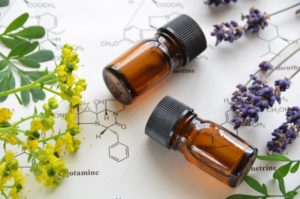How to Use Essential Oils for ADHD

Note: Prescription medication and Behavior Management (i.e. Parent Training) are first line treatments for kids with ADHD and related challenges. However, parents are always asking us about “natural” approaches. So we've invited functional medicine practitioner, Chantell Reagan, to write a series of articles to bring us all up to speed on “alternative” approaches to managing your child's complex issues. Please consult your child's physician to explore these ideas further. This is the fourth of five articles. You may want to start with the first articles in the series, “Taking an Integrative Approach to Raising Complex Kids” , “The Gut-Brain Connection in Complex Kids”, “Do Food Sensitivities & Allergies Connect to ADHD?” and Treating the Top Vitamin and Mineral Deficiencies in ADHD. ~ Elaine & Diane
One of the Oldest Forms of Natural Medicine
Though not regulated by the Food and Drug Administration, essential oils are one of the oldest forms of natural medicine on the planet. For thousands of years, essential oils were prized for their healing properties and treasured as a form of currency. Essential oils were often stolen from Egyptians crypts. There are over 300 references to essential oils in the Bible, including frankincense, myrrh, cedarwood, juniper, and coriander. Essential oils are the volatile oils obtained from plans, trees and flowers. They are comprised of hydrogens and oxygens in the forms of chemicals like terpines and alcohols that have specific chemical properties (i.e. anti-inflammatory, anticancer, etc).
In ADHD, there are several essential oils which have been shown to be helpful, including vetiver. In a case study of 6 children with ADHD from 2001, a physician researcher showed that vetiver “improved brain activity and reduces the symptoms”. Cedarwood also demonstrated similar findings, with lavender showing the least amount of effectiveness. However , lavender as well as ylang ylang can provide a calming effect and can help with anxiety as well. Universities like Vanderbuilt have integrated the use of essential oils to reduce stress and provide a calmer work environment. Additionally, rosemary, citrus (like lemon or orange) and peppermint oils are can help with memory and concentration. Frankincense, the “king of oils” has anti-inflammatory properties and can heighten cognitive function and clarity, while supporting emotional wellness.
Article continues below...
Treatment for your Child's ADHD
Download a free tip sheet "Recommended Treatment for ADHD: Medication & Behavior Management" for what's really recommended for your child or teen.
Quality Does Matter
When selecting an essential oil brand, the quality does matter. Natural and “pure” oils are the most common type found in the market, but they are still overly processed, so they lose their healing properties. Certified therapeutic grade (CTG) oils are medicinal-grade and are the highest grade of essential oils with greatest healing properties. It's also important to select a manufacturer who adheres to strict third-party testing to ensure that the oils contain the correct chemical components.
Two Great Ways to Incorporate Them into Everyday Life:
Inhaling the oils or using them topically on the skin represents two great ways to start incorporating them into your everyday life. The nasal passages can easily absorb the properties of the oils, so adding 3-4 drops of an essential oil to a diffuser can enhance the therapeutic effects.
Additionally, essential oils are well absorbed through the skin and can be used topically. Essential oils are generally safe, but can produce skin reactions for some with sensitive skin. I recommend applying 1-2 drops of EO to a patch of skin such as the forearm. Observe that area of skin over the course of 1-2 hours for any noticeable reaction; usually reactions occur within 5-10 minutes. If you experience a hot or burning sensation or if you develop a rash, add a “carrier” oil like coconut, jojoba, olive or grapeseed oil to the site. Never use water, as it can add to the discomfort. For more safety information, the Atlantic Institute of Aromatherapy houses a comprehensive database of injury reports for essential oils. The oils can be applied to the back of the neck, wrists, bottom of the feet or behind the ears, where the oils can be easily absorbed. You can also use a rollerball to blend your oils to make topical use easier. Simply add 5-10 drops of your oil(s) of choice and fill the rollerball with fractionated coconut oil.
Essential oils represent another alternative to help with ADHD related symptoms. It's always best to discuss using the oils with your practitioner prior to using them.
References.
Atlantic Insititue of Aromatherapy. Accessed on February 6, 2016
Brain Balance Centers. Essential Oils for ADHD. Accessed on February 6, 2016
Friedmann, T. Attention Deficit and Hyperactivity Disorder (ADHD). Case study accessed on February 6, 2016
Healing Oils of the Bible. Accessed on January 31, 2016.
McBride T and Sturges T. Opening Minds Closed to the Possibilities of Using Essential Oils. Essential Science; 2013. Accessed on February 6, 2016

